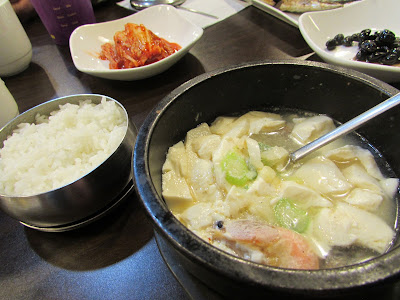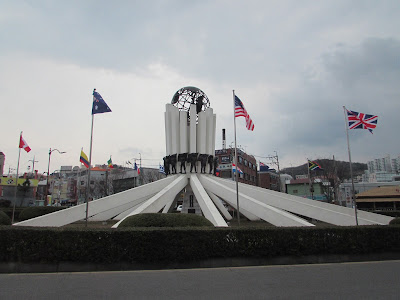 |
| The port at Busan |
We were off the ship on time and quickly went through the customs/immigration. Once in the terminal, we looked for our guide. No sign of him so Penny asked the ladies at the information desk to call the tour company. Seems there are three cruise terminals in Busan and he had been sent to the wrong one.
While we waited for him, we enjoyed the music provided in the terminal and the welcoming young people in traditional costume.
Once our guide showed up, we headed to our first stop, Yongdusan Park. Located high on a hill overlooking Korea's second largest city, we spent a leisurely time admiring the scenery and the grounds.
Yongdusan means "Dragon Head Hill", and here is the statue.
The Busan Tower is an observation deck.
And so did our leader, Penny
After leaving the park, we traveled across a bridge that went in circles before crossing the harbor!
We were headed over to the Busan Modern History Museum.
It might as well be named the Busan Museum of Japanese Aggression, because that's basically the focus of every exhibit.
Modern history has given Busan plenty of reason to dislike its neighbor to the east. Korea has always been battered back and forth between the powers of Japan and China, who took turns possessing, threatening, attacking and pillaging. Busan is the closest point of entry for the Japanese, so it makes sense that this city has borne the brunt of their abuse.
The museum paints a grim picture of life under the influence of the Japanese. They came to control most of the city and as the years wore on, Koreans were forced into Japanese armies and even sold into sexual slavery--an outrage for which, the museum notes, "Japan has never apologized".
When Korea finally got back on its feet in 1950, North Korea attacked...and the rest is history.
We then took a bit of a walk and headed to the big fish market. Along the way was a temple with a large buddha. Buddhism is the main religion in Korea.
 |
| Gary and Mary |
Inside the building were aisles and aisles of tanks with a variety of fish and creepy-crawlers with tentacles.
And then our guide announced it was time for lunch! Oh, yum!
We walked over to the restaurant and the food was mainly typical Korean style, which means hot and spicy and LOTS of fish in various dishes!
Terry's expression accurately displays our feelings about the food; I was just happy there was plenty of sticky rice!
After lunch we headed over to the Haedong Yonggungsa Temple...or as we would say.. the Buddhist temple by the sea.
My zodiac statue...
Haedong Yonggung temple was built back in the 1300’s by an important Buddhist teacher. The main sanctuary was built in the 1970’s and there are various viewpoints around the temple looking out to the ocean. It takes 108 steps to the main sanctuary area which makes for a nice walk and some beautiful views.
We peeked inside the main sanctuary. Some come here to worship.
A close-up of the buddha statues.
It is rare to find a temple on the seashore; most temples in Korea are located in the mountains.
Our last stop for the day was to the UN Memorial Park located in the middle of the city. This is the only United Nations cemetery in the world and is the final resting place of 2300 men from 16 nations that supported the South in the 1950-53 Korean War. The Korean government has pledged to maintain this park as a cemetery for eternity.
Our day at port had now come to an end and it was then time to say goodbye to Busan and our guide as we returned to the ship.
To continue reading, scroll up towards the top of this page and click in the right-hand column the entry entitled: Jeju Island, South Korea.














































No comments:
Post a Comment